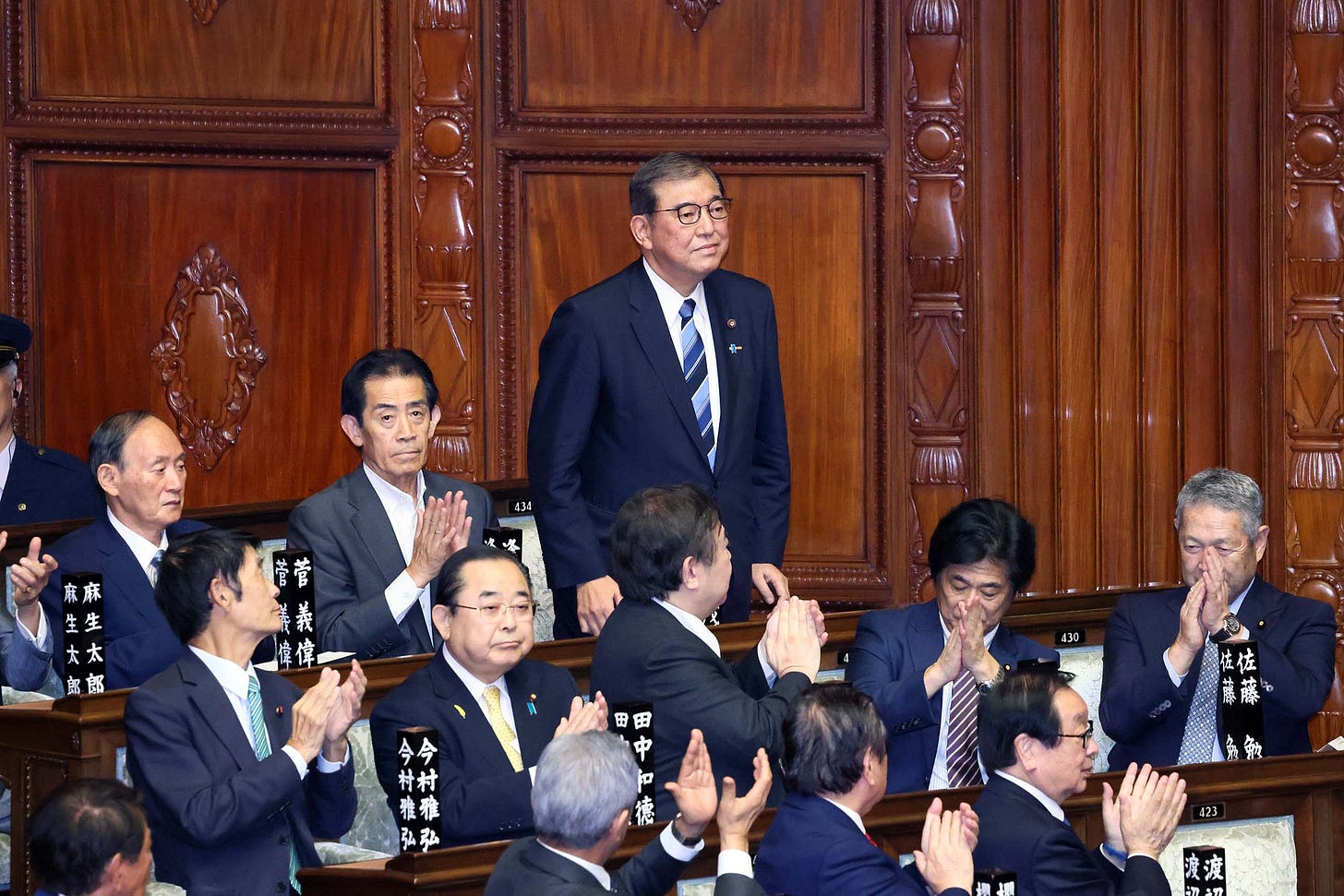Ishiba takes over | Today in Japanese politics
The Diet picks a new prime minister, who faces a divided LDP and an opposition that may be working towards electoral coordination
Thank you for reading Observing Japan. With Japan now heading into general election season, I will continue writing roundups of major political news multiple times per week instead of weekly for paying subscribers.
If you are looking for timely, forward-looking analysis of the stories in Japans’s politics and policymaking that move markets, I have launched a new service through my business, Japan Foresight LLC. For more information about Japan Foresight’s services or for information on how to sign up for a trial or schedule a briefing, please visit our website or reach out to me.
Thank you again to those who participated in the prediction contest. I will be in touch with winners. Only three people picked Ishiba to win.
I have a new essay for Nikkei Asia, “New Japan PM Ishiba needs public support to fend off Abe loyalists,” available here. I will be writing more about this in a separate post soon.
The rundown

The Diet formally selected Ishiba Shigeru as Japan’s prime minister, succeeding Kishida Fumio. Ishiba has already indicated that he will dissolve the House of Representatives on 9 October for a snap election on 27 October. His newly confirmed cabinet features many political allies and virtually none of Takaichi Sanae’s supporters, reflecting a growing division within the Liberal Democratic Party (LDP) that could threaten his premiership. Opposition parties criticized Ishiba for reversing earlier pledges to delay a snap election; the Constitutional Democratic Party (CDP) and other parties are looking at coordination in constituencies held by lawmakers implicated in the kickback scandal. Ishiba and his cabinet, meanwhile, have sounded cautious notes on monetary policy, while in foreign policy, Ishii Keiichi, new head of junior coalition partner Kōmeitō, said that he hoped Ishiba would pursue a “realistic line” in regard to Ishiba’s ambitions to create an Asian NATO and revise the US-Japan status of forces agreement (SOFA). Plus: further reading on Kishida’s post-premiership role, Koizumi Shinjirō’s failed leadership bid, and a new party for Maehara Seiji.
Ishiba government

On Tuesday, 1 October, Kishida Fumio formally left office – after a rush over the weekend to vacate the Prime Minister’s Residence – as Ishiba Shigeru was formally selected by the Diet to become the leader of Japan’s one-hundred-and-second cabinet. At 1,094 days, Kishida’s tenure was the eighth-longest among postwar prime ministers.
Despite potential conflict within the Liberal Democratic Party (LDP), there were no defections in the parliamentary vote to confirm Ishiba as the new prime minister, though in the upper house, one member of the NHK Party cast a vote for Takaichi Sanae and another for Motegi Toshimitsu. Following his selection, Ishiba met with opposition party leaders and new Kōmeitō chief Ishii Keiichi, assembled his new cabinet, and was formally invested in office by the Emperor.
The nineteen members of the Ishiba government include two holdovers from the outgoing Kishida government – Chief Cabinet Secretary Hayashi Yoshimasa and Minister of Land, Infrastructure, Transportation and Tourism Saitō Tetsuo – and has thirteen first-time cabinet ministers. Only two cabinet ministers are women, compared with the five in Kishida’s last cabinet. It is a strongly “Ishiba-colored” cabinet. Six of twenty Ishiba’s endorsers, included new Foreign Minister Iwaya Takeshi, who managed his campaign, are in the cabinet. Ten of nineteen have no factional affiliation. There are no ex-Abe faction members (and one member, Minister of Internal Affairs Murakami Seiichirō, who after the assassination called Abe Shinzō a “traitor,” for which his right to hold party executive posts was suspended for a year). While the average age – 63.5 – is roughly equivalent to the preceding cabinet, there are no cabinet ministers in their forties (there were two in the last Kishida government) and three in their seventies. Eight members, including Ishiba himself, have had contact with the former Unification Church in some form.
Keep reading with a 7-day free trial
Subscribe to Observing Japan to keep reading this post and get 7 days of free access to the full post archives.




